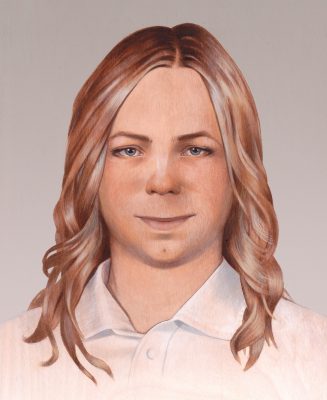Last autumn I listened to an episode from the 1999 ‘Lock Up’ series of This American Life, which explored the way prisoners represent their identities visually once they have been released. During the podcast, an ex-detainee explained that during incarceration he and his fellow convicts ‘had very little to see or look at, in terms of variety, in terms of what one had become used to. Seeing people come and go, different distances, different colours, different lives, all just one vague big grey soup.’ What struck me most about his comments was how starkly prison-industrial complexes violate the agency of those they detain, limiting prisoners’ ability to connect with each other and the outside world, and most of all, denying any assertion of individual identity. I began to wonder how writing and visual art could help represent prisoners deemed invisible by wider society. Interviews, such as the one in the podcast, contribute to building a biographical narrative of a subject – but what about photographs, portraits and paintings? What might an ethical portrait of a prisoner look like? Could art be used as a tool to give agency back to those on the inside? Or rather, who do prisoners rely on to construct images of them from the outside, in the face of a system which seeks to siphon off all humanity?
*
The dehumanisation of transgender prisoners is by no means unfamiliar, but the trial, prosecution and release of Chelsea Manning has shifted the rhetoric of both media and personal representation into a different realm. During her incarceration I knew of Manning as someone both famous and infamous, whose identity as a trans woman and committer of treason has been widely sensationalised. A United States Army soldier, Manning was convicted under the Espionage Act and for a number of other offences in 2013 after she ‘leaked’ over 700,000 sensitive diplomatic documents to the secret sharing site Wikileaks. The files contained war logs from Afghanistan and Iraq, diplomatic cables from the state department and documents on Guantanamo Bay. After pleading guilty to ten of the twenty-two charges of which she was accused, Manning was sentenced to thirty-five years imprisonment at Fort Leavenworth, Kansas. Several years before her sentencing, she had also spent three years in detention centres such as Camp Arifjan in Kuwait, alongside prisons in Virginia, Kansas and Maryland, where she waited to hear the length of her sentence. There, Manning was held for twenty-three hours a day in solitary confinement, with no sunlight.
As Manning’s case unfolded, I kept many jottings, notes and screenshots of news reports. What grips me about her case is the complexity of its legality in relation to war and surveillance, intensified by the complex ethical questions produced by her gender transition. Who was this woman, who appeared to be so integral to, yet so mistreated by, the state? In the margins of a printed-out TIME article from 2015 entitled ‘Chelsea Manning Can No Longer Be Called “He” by the Military, Court Rules’, I wrote: ‘How does the prison-industrial complex monitor, represent and treat transgender inmates?’ A simple question, but I soon discovered that the attention given to Manning’s case was symptomatic of the widespread brutality of the American justice system. Transgender inmates can arouse confusion and rage in society at large, making them more vulnerable to mistreatment and violence. They are sanctioned, ignored and deemed unworthy of protection. Throughout my research I found that it is usual for transgender inmates to be admitted to the incorrectly gendered prison. Activist group Black & Pink’s 2015 national LGBTQ prisoner survey ‘Coming Out of Concrete Closets’ reported that ‘23 per cent of transgender, nonbinary gender, and Two-Spirit respondents are currently taking hormones in prison, while an overwhelming 44 per cent report being denied access to hormones they requested.’ Manning was refused hormone treatment, rejected for psychological help and relentlessly placed in solitary confinement as a penal strategy. Her detention – her isolation and torture – is the story of many; it is by no means exceptional.
It fascinated me to consider how empathy could materialise as visual art. I wanted to meet Manning, I wanted to talk to her personally and understand her own desire for representation. In retrospect, collecting these articles was a way for me to reappropriate news reports – to uncover alternative narratives surrounding Manning’s case, avenues through which to interpret her mistreatment. The headlines were painful reminders of Manning’s suffering. I began to wonder what would have happened if Manning’s sentence hadn’t been commuted by Barack Obama in 2017: how much longer would she have been kept in solitary confinement?
Detention is imposed in order to sanction, isolate and divide. The rise in supermax prisons (originating in Arizona and California) since the 1980s has amplified the prosecution and punishment of those deemed delinquent by society. A particularly harrowing example is the recently closed ‘tent city’ in Arizona, a fully functioning concentration camp in Maricopa County, advertised to those it incarcerates as an alternative to serving longer sentences. Inmates are told that if they submit themselves to living in temperatures as high as 120 Fahrenheit they can have days shaved off their sentence, as a capacity-enhancing possibility for ‘doing time’. It is very difficult to gain access to these prisons, and consequently I have never visited one, though I have exchanged letters via Jmail (an online service for writing electronic messages to prisoners) with a woman who was incarcerated in Pelican Bay State Prison, Del Norte County, California. She explained that in supermax prisons, psychological damage is perpetually exacerbated by government authorities. Due to the privatisation of prisons across the United States, those detained are seen as capital, little more than objects for financial gain.
Prisons are a tool of power and rule, and manifest as a form of domination and oppression. But a representation of an individual prisoner has the power to restore and extend the visibility of all inmates and their legitimacy to wider society. In her essay ‘On the Intersection of the Military and the Prison Industrial Complex’, Manning wrote that ‘the prison industrial complex had the power to imprison me and label me as an offender for life’. Within prison, communication technologies such as mobile phones and the internet are limited; prisoners communicate with the outside via paid outlets Jmail, Corrlinks and JPay, as well as handwritten letters and phone calls, which often only last fifteen minutes and are regulated by prison authorities – all part of the way prisoners become invisible to the outside. While incarcerated, Manning regularly wrote articles for The Guardian, and it was a point of public discussion as to whether this counted as an unfair liberty, manipulating her profile within society. But in July 2016, the news that Manning faced solitary confinement – and the ceasing of her usual scheduled phone calls – for her suicide attempt at Fort Leavenworth horrified activists. There is an aggressive undervaluation of mental health in institutionalised settings such as prison – supposedly a site of ‘reform’ – where inmates are often denied therapies, hormone treatment and counselling. Social deprivation, in an interpersonal sense, is not just constructed by limited human contact, but also by the constraints imposed by the physicality of inhumane environments.
In an article for The Guardian in May 2016, Manning described that whilst placed in solitary confinement – in a 6 Å~ 8 ft cell – ‘I was not allowed to lie down. I was not allowed to lean my back against the cell wall. I was not allowed to exercise.’ Such an environment only furthers isolation and deepens identity issues, making any affirming connection with the outside world all the more urgent and valuable.
*
A month before her arrest in April 2010, Manning attached a black-andwhite photograph in an email to retired Sergeant 1st Class Paul Adkins with the subject line ‘My Problem’. This photograph of Manning in a car seat wearing a blonde wig and make-up – since widely circulated – has been considered her first attempt at asserting her gender identity. The email reportedly contained the line: ‘I don’t know what to do anymore, and the only “help” that seems to be available is severe punishment and/or getting rid of me.’ When she was trapped in solitary confinement, the Chelsea Manning Support Network released a similar statement on Manning’s behalf: ‘I need help. I am not getting any. I have asked for help time and time again for six years and through five separate confinement locations.’ After the release of such viscerally charged statements, and after a week-long period of hunger strike, Manning was permitted sex reassignment surgery in September 2016.
Two years previously, the Chelsea Manning Support Network had decided to commission a portrait of Manning, in an attempt to ensure that her representation in the media would reflect her expression, and mitigate the disjunct in identity she had previously experienced. Under US Army Regulation 190–47, prisoners ‘will not be photographed, except in support of medical documentation and for facial identification purposes’. As Manning could not sit for a portrait in prison, there needed to be alternative artistic avenues to mitigate what the Support Network saw as the visual mistreatment of her in the media, to allow Manning to take control of her image from inside Fort Leavenworth. The Support Network approached Alicia Neal, an artist and illustrator from Philadelphia, to create an image that could be utilised across media outlets as Manning’s ‘official’ portrait: an artistic intervention to revolutionise Manning’s media coverage. I found Neal’s website; her practice appeared kitsch and enigmatic in colour, often finding its subject matter in folklore and paganism. I was curious to know why the Support Network had chosen to contact her specifically. I’d read that she had had to work from photographs of Manning, sending drawings to Fort Leavenworth, waiting for a response and redrawing accordingly. I came to understand that the ethical implications of this image involve every aspect of its conception – from the intention behind the commissioning process, the overcoming of the constraints of prison, through to the creation of the image and its distribution.
Neal’s portrait could only be ethical if its pursuit was a realistic representation of Manning. But how was this possible, when she was unable to see Manning in the flesh? The idea of a caricature or impressionist portrait seemed to defeat the purpose of reinstating agency for someone who had so emphatically been denied it. Neal’s portrait is a gesture that seeks to preserve and reimagine Manning as human, and not a subject defined by rule and law. This portrait is not just the face of a woman who needed an alternative portrait, it is the portrait of a society which misrepresents, and refuses to acknowledge, individuals who do not conform to its expectations.
I knew I could only confront the intricacies of the portrait by speaking directly to Alicia Neal. I wanted to hear how Manning came to trust her; about the dynamics of their intangible relationship. I wanted to know under what conditions the portrait emerged, and who it challenged. Neal promptly replied to my first email, in December 2016, proposing an interview: ‘I am happy to help. I’d like to mention first and foremost that I’ve never had direct contact with Chelsea.’ We arranged to talk a week later.
*
Before investigating the image of Manning, it is important to mention that there are many other examples of what I have come to perceive as ethical and unethical portraits of prisoners in society and the media. Courtroom artists undergo the difficult task of representing those on trial objectively, whilst retaining a level of professionalism in a heightened emotional environment. Artists and activists have also explored the role of portraiture as a satirical measure, employing humour as a political act against dehumanisation. A project launched by activist/artists Jeff Greenspan and Andrew Tider in 2015 entitled Captured: People in Prison Drawing People Who Should Be sought to draw a comparison between those who are incarcerated for crimes, and those who are not held accountable and walk free – exploring the attendant questions of class and race. I was especially moved by Prison Landscapes (2013) by artist Alyse Emdur – a book which brings together a collection of 100 photographs of prisoners as they stand in front of painted backdrops in prison visiting rooms. Many of these reference natural landscapes: waterfalls, tropical beaches and sunsets mount the prisons’ grey walls. Also of note is the job of forensic sketch artists, who use image modification/identification, composite imagery, e-fits and postmortem drawings as methods to apprehend or identify those who cannot be found physically. Often the artist interviews the witness or victim in person to gain a first-hand account of their lived experience, which is then translated into visual material for the police. It is these complicated negotiations of constraint, subversion and representation which are so compelling to me, particularly in the case of Manning.
I have come to understand an ‘ethical portrait’ to be a depiction of someone which holds political weight, is integral and empathetic; which challenges marginalisation through a visual image. Mugshots are a protocol of the justice system’s implementation of discipline – they are the least merciful representations of prisoners, which demand their subjects to act as if they are already corpses, staring into the camera with morose expressions, wearing the uniform orange jumpsuits which signal their new societal status. Although Neal’s portrait does not intend to mimic a mugshot, it does focus on Manning’s face and shoulders, displaying some similarities to traditional portraiture and police photographs. Neal explained that Manning’s mugshot, if one existed, was never used in the media, which instead tended to illustrate articles with ‘her official military portrait of Bradley’; but, she says, ‘I think that it switched into that terrible selfie once she declared that she was transitioning, because there was no other option.’ That ‘no other option’ is imperative here. Neal was keen to explain that the black-and-white selfie of Manning was ‘circulated like a mug shot’, which was ‘very damaging to her image’, but it was not Manning herself but the Support Network which decided to commission the new portrait. In replacing the military photograph with all its associations, Neal’s portrait serves as a site of solidarity for Manning.
In the portrait Manning is presented as calm, composed and comfortable in her expression and gender, with what Neal has described as a slight ‘Mona Lisa smile’. The background is neutral, as is her shirt; the portrait’s fundamental purpose of expressing a lived experience, as opposed to a speculative artist’s impression, shines through. It became increasingly apparent that Neal’s ethical position was to put Manning’s desired representation first, ahead of her own creative agency as an artist. Neal told me that this portrait – constructed entirely from existing drawings of Manning – differed from her usual mode of working, which would involve extensive photography and discussion with the subject. ‘I wanted the portrait to be the best representation of her,’ said Neal. ‘My main focus was giving her the dignity of at least being seen as who she wants to be… what I thought she would look like realistically, and not like this fantasy character.’ The portrait mediates between society’s perception of Manning’s identity, and the way she truly wants to be seen: it endeavours to uphold her lived reality of the inside from the outside. It demonstrates how our sense of self often forms in union with the conditions of our environment, our experiences and influences – which, in Manning’s case, involve subordination. ‘I’m not a very political person,’ said Neal, ‘but I support Chelsea as a trans person, so I feel like this is sort of my contribution.’
Neal told me that many people have speculated whether Manning received ‘special treatment’ as a political prisoner, being allowed to write, undergo gender transition surgery and have a portrait made. But in 2016, when I interviewed Neal, Manning was still detained in Fort Leavenworth with no future discussion of release, and subject to another twenty-eight years of imprisonment. Release was a hypothetical future imagined by the Chelsea Manning Support Network: until that point Manning remained removed from society, defined and represented by the institutions in which she was incarcerated. Manning wrote about this state of non-being in December 2015 (her sixth Christmas in prison) in an article for The Guardian, for which she regularly wrote from within Fort Leavenworth. ‘Living in a society that says “Pics or it didn’t happen”, I wonder if I happened. I sometimes feel less than empty; I feel nonexistent.’
From this comment, I came to interpret the portrait as a gesture of empathy transformed into an event of justice, a visual representation of existential worth. Manning, Neal suggests, has ‘been demonised left and right, and I think it’s hard for people to see her as a person… the intention was to make it as serious and conservative as possible so that she would be taken seriously. I wanted to give her the dignity of at least being seen as who she wants to be, because I have trans friends and I’ve seen them go through the transition and how hard it can be to represent yourself and make people see you as you.’ Her work reimagines Manning sympathetically as a political prisoner, and liberates her image from a punitive construct. When the portrait was released on the Chelsea Manning Support Network site in May 2014, there was a sudden shift in the press, as the new image replaced the military photograph; Manning’s suffering in relation to her gender identity was no longer hypothetical, but newly validated. Neal’s portrait makes the statement that Manning’s identity has nothing to do with her imprisonment. It reminds us that we are not solely defined by the institutions and environments we are subject to and conditioned by, that we do not have to stand for the myriad ways in which society is numb to those who are marginalised. My conversations with Neal showed me that images – in contradictory and mysterious ways – can be actions and social commentaries. Her portrait attempts – through medium, form, context and content – to fundamentally change the meaning of what art can do in society.
*
A great relief swept over me when Obama granted Manning’s clemency on 17 January 2017. Manning was no longer a detainee waiting indefinitely for an end, but a political prisoner who has been redefined as human. Before Manning’s release, a Google search for images of her showed three Mannings: the army photograph from before her transition; the grainy, bewigged, monochrome selfie; and Neal’s portrait. After her release was announced for 17 May 2017, Manning began to release a steady stream of new public images. First, an Instagram shot of her two feet with the tag line ‘First steps of freedom!! :D’, followed, a few hours later, by a slice of pizza. Her Instagram – xychelsea87 – operates as a space for humour and self-expression. On Twitter, Manning’s use of emoji has become an idiosyncratic appraisal of Trump’s presidency. A recurring tweet reading ‘We have more power than they do’ and ‘#WeGotThis’ is perhaps the most optimistic example of the way Manning is now using her persona as a political self-portrait, employing social media as a tool to reclaim the voice she was denied within prison. ‘I could not go on living in the wrong body,’ she explained in her first video interview with ABC News in May 2017. ‘I used to get these feelings where I just wanted to rip my body apart.’ Despite these horrifying, visceral words, I felt warmed by seeing her speak on national news, embodying the freedom Neal’s portrait sought to create. Among my favourite of her self-portraits is a photograph of her in Times Square smiling enigmatically, with the ABC interview on a large screen behind her.
The magnificent photograph of Manning published three days after her release, where she peers into the camera sideways, dressed in a black, slightly unzipped jacket, is perhaps the most stoic of her current public portraits. It is not a substitute for her experience – it is her lived experience. Through choosing how to be photographed, Manning is permitted complete control over her expression, clothing, environment and posture. I read this image as a political action against dehumanisation: a small reminder of the power of empathy.




